
This post may contain affiliate links or sponsored content. That means if you click on my link and buy something, I will earn a small commission from the advertiser at no additional cost to you. For more information on this, please click here.
Lemony Pasta with Peas and Ricotta is a delicious spring pasta dish that is incredibly simple and quick to make, yet delivers big time on flavors, beauty and aroma! Plus, it’s very hearty and super satisfying.

Mix up your weeknight menu with this easy pasta dish your whole family will love!
Pasta with Peas and Ricotta is a very simple, straightforward recipe that can essentially be made in the time it takes to boil water and cook pasta. It’s ideal for a last minute weekday meal, but also perfect for a weekend brunch.
Creamy ricotta is combined with sweet green peas, sautéed shallots and lots of lemon to make the most delicious light and creamy sauce. Tossed with pasta, parmesan cheese and fresh mint, this recipe comes together quickly with just a few key ingredients. A great way to greet spring, warmer weather and longer days!
If you love ricotta cheese like I do, also check out Bucatini Pasta with Ricotta, Slow-Roasted Eggplant and Tomatoes and Pasta alla Checca in a No-Cook Tomato Sauce with Ricotta.

Ingredients for Pasta with Peas and Ricotta
To make this delicious Italian spring pasta dish, we’ll need:
- Peas: Frozen sweet peas or baby peas work really well in this recipe and are what I used. Of course, fresh peas can be used when in season, but are difficult to find year-round. I always keep a bag of frozen peas in the freezer so that I can make delicious recipe like this in a pinch! I do not suggest using canned peas.
- Ricotta Cheese: The creamy, rich sauce base in the recipe. Whole milk ricotta will give you the creamiest version, but part skim can be used if you desire. Note that you may not need to add much or any salt to the recipe because of its high cheese content. Just season to taste.
- Shallots and Garlic: The mild flavor of shallots and sharpness of garlic are just what this recipe needs to complement the rich ricotta sauce. Spring onions are a great alternative to shallots when in season. Use as much or little of garlic as you’d like!
- Lemon: Fresh lemon juice and zest contribute to the signature, bright flavors in this dish and are just wonderful. Be sure to zest the lemon before you squeeze them for juice!
- Fresh Mint: Though optional, mint is a really great herb that adds lots of character to this recipe. It complements the lemon and peas so well! Plus, it adds a touch of Sicilian-ness to the dish.
- Butter: Used to sauté the shallots and other aromatics at the beginning of the cooking process. If you prefer to not use butter, you can substitute it with extra virgin olive oil.
- Cheese: Savory parmesan or Grana Padano are mixed into the ricotta and pea sauce at the very end for added flavor and depth, but sharp, sheep’s milk Pecorino Romano cheese would also be great here.
- Pasta: While I used farfalle in this recipe, any short or long pasta would work. Some of my other favorites to use in this recipe are fettuccine, fusilli, penne rigate and gemelli. The subtle nuttiness of a whole wheat or farro pasta also works really well in this dish.

How to Make Pasta with Peas and Ricotta, Step-by-Step
Here are the main steps for how to make this pasta with ricotta peas and lemon:
- Gather and prep all ingredients. Bring a large pot of water to a boil.
- PRO TIP: Be sure to zest the lemons before juicing them!
- Melt butter in a skillet over medium-low heat. Then, add shallots, fresh mint, if including, and chopped garlic. Cook until the shallots are translucent, softened and caramelized a bit, stirring occasionally, about 8 minutes or so.
- PRO TIP: You can cover the pan to speed up this process, if desired.


- Then, add the peas and lemon zest and cook until the peas are tender. Add a couple tablespoons water to the pan to deglaze it, if necessary, using a wooden spoon to scrape up all the brown bits from the bottom of the pan. Season to taste with salt and pepper, then turn off the heat.
- PRO TIP: If using freshly shucked peas, they take longer to cook than frozen peas and should be simmered in a bit of liquid. Add a bit of water or low sodium broth along with the peas when you add them to the pan.


- Cook pasta in salted boiling water for 2 minutes before you think it is al dente. Be sure to reserve at least 1 cup of the starchy pasta cooking water.
- After the pasta has been cooking 5 minutes, turn the heat on the pan to medium and stir in the ricotta cheese along with ½ cup pasta water to finish the sauce.



- Transfer the pasta to the pan, along with the lemon juice, and allow it to finish cooking in the wonderful flavors of the sauce. Add enough pasta water to bring the sauce together, about ½ cup at a time. Mix well.


- Once the pasta is al dente, turn off the heat and fold in the grated cheese, a big pinch of freshly ground pepper and the remaining mint, if including. Drizzle lightly with some extra virgin olive oil. Stir well, then transfer to a serving platter. That’s it!

More Spring Pasta Favorites
Here are few other pasta recipes that are perfect in springtime:

Frequently Asked Questions
Fresh Peas are great to use when in season! They take longer to cook than frozen peas, fyi, and should be simmered in a bit of liquid. Add a bit of water or low sodium broth along with the peas when you add them to the pan. FYI, you’ll need roughly 2½ pounds of fresh peas in the pod to yield about 3 cups shucked peas.
It’s very easy, albeit a bit time consuming. Squeeze the pod between your thumb and fingers along the seam to open them. Then, gently push the peas out with your fingers. Discard any peas that are discolored, and rinse well before cooking. Click here for a video demonstrating it.
Choose crisp and plump, well-filled, deep green pods without wrinkles or spots. There should be some air space between the peas as very full pods are likely to contain tough peas.

TOP TIPS FOR PASTA WITH PEAS AND RICOTTA
- Fresh Peas are great to use when in season! They take longer to cook than frozen peas, fyi, and should be simmered in a bit of liquid. Add a bit of water or low sodium broth along with the peas when you add them to the pan.
- Serving: Enjoy this recipe with some chicken cutlets, Italian sausage or meatballs along with a simple mixed green salad–delicious pairings! In a smaller portion, it would be a great first course for a baked glazed ham at holiday time.
- Variations: Try this recipe with some pancetta, prosciutto or leftover ham sauteed at the very beginning and topped with chopped fresh chives or roasted pistachios. All are great variations on this recipe!
- Leftovers: Store leftovers in an air-tight container in the refrigerator for up to 3 days. Reheat them in a partially-covered skillet over medium-low heat with a little water until heated through.
More Great Recipes to Try
I hope that you are enjoying my Italian food blog Mangia With Michele and all of my Italian recipes and Italian-American recipes!
If you’ve tried Pasta with Peas and Ricotta or any other recipe on the blog, please let me know how it went in the comments below — I love hearing from you!
You can also FOLLOW ME on FACEBOOK and INSTAGRAM to see more delicious food and what might be going on behind the scenes!

Lemony Pasta with Peas and Ricotta
Equipment
- 1 Cheese grater (optional)
Ingredients
- 4 Tbsp butter
- 1½ cups thinly sliced shallots, about 3 shallots
- ¼ cup chopped fresh mint leaves, divided (optional)
- 2 Tbsp chopped garlic
- 1 pound peas or baby peas, frozen or fresh, about 3 cups
- Zest of 2 lemons
- To taste salt and black pepper
- 1 pound pasta + salt for pasta water
- 1 pound ricotta cheese, about 2 cups (can use a 15-ounce container)
- Juice of 2 lemons (about 4 Tbsp)
- ⅓ cup grated parmesan cheese or Grana Padano
- Freshly ground black pepper
- Extra virgin olive oil, for serving
Instructions
- Prep all ingredients according to specifications above. Bring a large pot of water to a boil. Zest the lemons before squeezing them for juice.(Please see the section above in the blog post for Step-By-Step instructions with photos.)
- Melt the butter in a large skillet over medium-low heat. Then, add the shallots, fresh mint, if including, and chopped garlic. Cook until the shallots are translucent, softened and caramelized a bit, stirring occasionally, about 8 minutes or so. You can cover the pan to speed up this process, if desired.4 Tbsp butter, 1½ cups thinly sliced shallots,, ¼ cup chopped fresh mint leaves,, 2 Tbsp chopped garlic
- Then, add the peas and lemon zest and cook until the peas are tender. Add a couple tablespoons water to the pan to deglaze it, if necessary, using a wooden spoon to scrape up all the brown bits from the bottom of the pan.1 pound peas or baby peas,, Zest of 2 lemons
- Season to taste with salt and pepper, then turn off the heat. (See NOTES below if cooking with fresh peas.)To taste salt and black pepper
- Meanwhile, add the salt, then the pasta to the boiling water, stirring frequently. Cook the pasta for 2 minutes less than the package directions, or about 2 minutes before you think it is al dente. Be sure to reserve at least 1 cup of the starchy pasta water.1 pound pasta
- After the pasta has been cooking 5 minutes, turn the heat on the pan to medium and stir in the ricotta cheese along with ½ cup pasta water to finish the sauce.1 pound ricotta cheese,
- Transfer the pasta to the pan, along with the lemon juice, and allow it to finish cooking in the wonderful flavors of the sauce. Add enough pasta water to bring the sauce together, about ½ cup at a time. Mix well.Juice of 2 lemons
- Once the pasta is al dente, turn off the heat and fold in the grated cheese, a big pinch of freshly ground pepper and the remaining mint, if including. Drizzle lightly with some extra virgin olive oil. Stir well, then transfer to a serving platter. Buon Appetito!⅓ cup grated parmesan cheese or Grana Padano, Freshly ground black pepper, Extra virgin olive oil,
Notes
- Be sure to zest the lemons before squeezing them for juice.
- Spring onions (the white parts only) can be used in place of shallots when in season if you can get your hands on some!
- Fresh Peas are great to use when in season! They take longer to cook than frozen peas, fyi, and should be simmered in a bit of liquid. Add a bit of water or low sodium broth along with the peas when you add them to the pan. (FYI, you’ll need roughly 2½ pounds of fresh peas in the pod to yield about 3 cups shucked peas.)
- There’s no need to defrost the peas if using frozen.

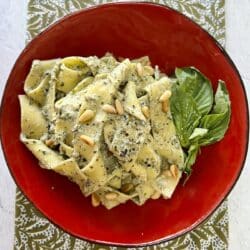
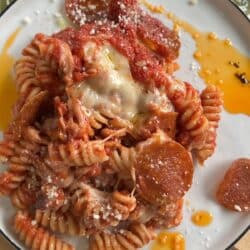
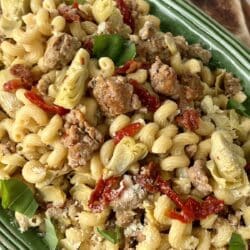
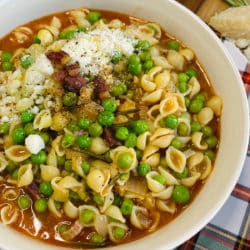
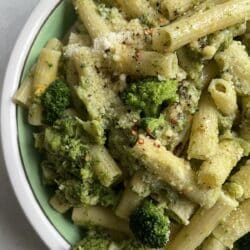
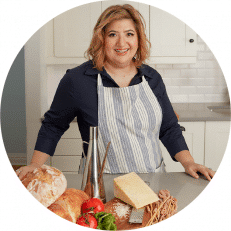
So easy to make-my whole family enjoyed this. Will definitley put on repeat!